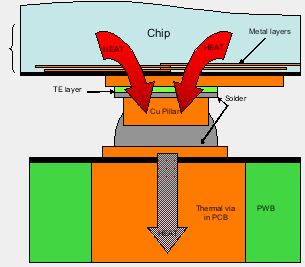Nextreme's thin-film thermal bump technology is actually a twist on existing chip packaging technology—so-called "flip-chip" packaging, which is currently used in high-speed microprocessors and GPUs from Intel, IBM, and others. In a nutshell, flip-chip involves building copper contact pads (for I/O, power, and ground) onto the surface of the processor die.
The die is then flipped over and placed face-down in the package, where those raised copper pads (or copper pillars) make contact with and sink down into a grid of solder balls. So the processor talks to the system by sending signals out through those copper pads into the package, and from the package to the socket.
Nextreme's big idea is to take those copper pillars and turn some of them into tiny Peltier coolers that can move heat off of small sections of the chip. (For a good, brief explanation of Peltier cooling, see the aforementioned Ars article.) As you can see from the diagram below, some of the copper pillars are still traditional power, ground, or I/O pads, while others would be there solely for the purpose of using the Peltier effect to move heat off of the chip.

More info at ARS Technica.